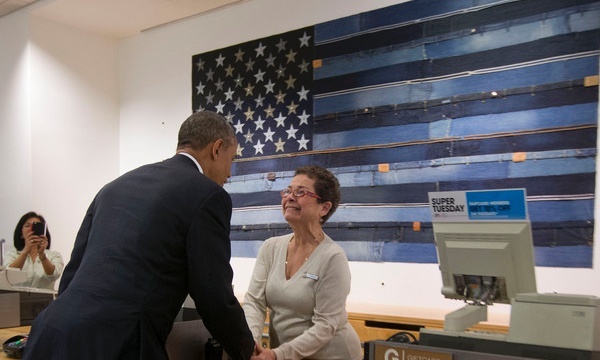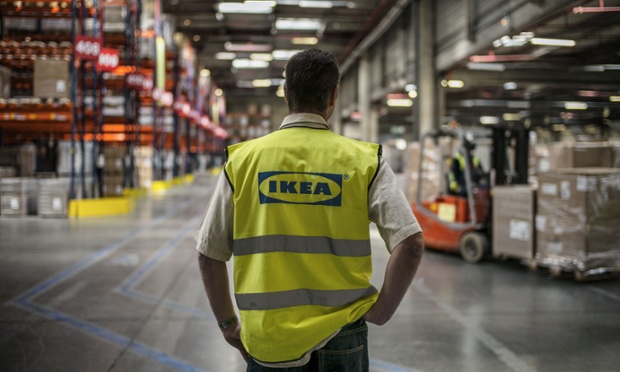
Date: 2024-10-19 Page is: DBtxt003.php txt00009340
Issue ... Wages
Companies ... WalMart, IKEA, GAP
Raising the floor: Walmart, Ikea and Gap lift wages for their lowest-paid workers
Burgess COMMENTARY
Peter Burgess
Raising the floor: Walmart, Ikea and Gap lift wages for their lowest-paid workers
Big companies have been increasing their lowest wages to improve productivity, turnover and customer service – and help accelerate the US economic recovery

Walmart employees wait for the start of a US associates meeting, part of the 2013 annual shareholders meeting in Fayetteville, Arkansas. Photograph: RICK WILKING/REUTERS
When Walmart posted its quarterly earnings on Thursday, one announcement stole the spotlight. It wasn’t about the company’s shares or revenue, but about its wages.
The retail giant announced that within the next six months, it will start paying all of its workers at least $9 an hour. That’s $1.75 more than the federally mandated minimum wage of $7.25 per hour, and on par with the mandated minimum wage in at least 20 states.
Walmart is not alone. Even as the federal and state governments have struggled to pass increase their minimum wages, some of the biggest US companies have been leading by example and setting wage floors – minimum hourly wages applied throughout a company – higher than legally required minimums. Other companies that have set wage floors above the federal minimum include warehouse club Costco Wholesale, clothing retailer The Gap, furniture seller Ikea and health insurance agency Aetna.
Walmart’s pay hike will put the earnings of its lowest-paid workers above that of other companies still paying the bare minimum. But while welcome, the move was also met with some disappointment. Some workers, who have spent the past year lobbying for a living wage of $15 an hour, insist that $9 an hour – while an improvement – isn’t enough.
Light in dark times: Ikea kicks off campaign to bring lights to refugees
“With $16bn in profits and $150 bn in wealth for the owners, Walmart can afford to provide the good jobs that Americans need – and that means $15 an hour, full-time, consistent hours and respect for our hard work,” says Emily Wells, a Walmart worker and member of OUR Walmart who earns $9.50 an hour and is only able to get scheduled for about 26 hours per week.
Walmart hadn’t responded to a request for comment by press time.
However, the company also announced it plans to raise its wage floor another dollar to $10 an hour in February 2016. That would still be less than the $10.10 per hour proposed by President Obama, but 38% above the current federal minimum.
Some companies have set even higher wage floors more in line with living wage expectations. Most recently, for example, Aetna set its floor for US workers at $16 an hour, twice the current federal minimum wage.
Higher wages are exactly what the financial doctors have ordered to cure America’s ailing economy. According to the Economic Policy Institute, it would take a wage growth of at least 3.5% to 4% for workers to feel the impact of the recovery. In 2014, the average hourly pay went up by just 1.7%.
“Raising wages among low-wage workers shifts income into the pockets of workers and families that are highly likely to quickly spend every additional dollar they earn,” says David Cooper, economic analyst at the Economic Policy Institute.
“So even though some businesses have to pay their workers more, they see more customers coming through the door because now there’s additional dollars rippling out through local economies in a way that doesn’t really happen if those dollars just go back into the bank accounts of corporate shareholders.”
Analysis Obama finds that $10.10 is not so easy as four states vote on raising minimum wage
Could ballot initiatives succeed where Congress and protests failed? A worker, a businessman and a lawmaker have their say
Wanted: companies to help spur a broader recovery
Unable to count on the Republican-held Congress to raise minimum wage, President Obama might have to look elsewhere to help drive America’s recovery. CEOs of companies like Gap and Aetna might prove to be worthy-allies.
“Since I became CEO, one of my goals has been to help re-establish the credibility of corporate America,” Aetna CEO Mark Bertolini said in a statement. “With these investments, we are leaning into the recovering economy and working to bring everyone along instead of just a few.”

President Barack Obama greets cashier Sonia Del Gatto at a Gap store in Manhattan during his unannounced shopping visit in March. Obama praised Gap, which earlier in the year announced it was raising its minimum wage for its employees. Photograph: Martinez Monsivais/AP Photo
Aetna’s decision to increase its minimum base wage and reduce out-of-pocket health care costs for its employees comes at the time when many low-wage workers are still not reaping the benefits of the recovery. In addition to building a healthier and more productive workforce, the company hopes to increase its employees’ financial security, says Cynthia Michener, a spokesperson for Aetna.
Aetna estimates that about 5,700 workers will see bump in pay when its new floor takes effect in April. On average, that increase should be about 11%. For some, it will be as much as 33%. In 2016, the company will also cover more health care costs for about 7,000 of its employees, saving some as much as $4,000 annually.
Customer service: better-paid workers are happier workers
Last year, Gap also got attention – not just from the media, but also from the White House – with its Do More campaign, in which the clothing retailer announced that it would raise hourly pay for its US employees to at least $10 an hour by June 2015. Obama visited a New York-based store to “congratulate the Gap for doing the right thing”.
Doing the right thing wasn’t Gap’s main reason for raising its wages, though; improving its customer service was. Better pay will help attract and retain “great talent” and provide better in-store and digital experience, says Paula Conhain, a spokeswoman for Gap.
“Raising the minimum wage is like any strategic investment we may make, such as investing in marketing or technology,” Conhain explains. Since the announcement, Gap has seen a double-digit percentage increase in the number of employment applications it has received. The announcement also led to an increase in employee pride, according to an internal employee opinion survey.
Aetna, a health insurance provider, also acknowledges that customer service is an important component of its business model.
“As healthcare moves to a consumer industry, Aetna is investing in the employees who interact with our customers every day,” Michener says.

An employee is at work at a warehouse of world’s largest furniture retailer Ikea. Photograph: JEFF PACHOUD/AFP/Getty Images
Besides happier staff and customers, companies that have raised their wage floors have reaped other benefits such as lower turnover and higher productivity. Businesses could also spend less recruiting, hiring, and training new workers, Cooper says.
It might take some time for those benefits to become apparent. For Ikea, which raised its US wage floor by 17% to $10.76 an hour starting 1 January, it’s still too early to tell if the raise is affecting staff turnover, says Tracey Kelly, corporate communication manager for Ikea US. But she says the staff has been “very pleased” with the increase.
The values-led business hub is funded by SC Johnson. All content is editorially independent except for pieces labelled “brought to you by”. Find out more here.